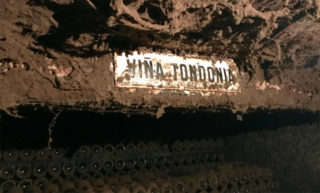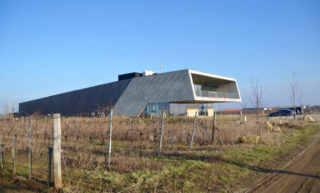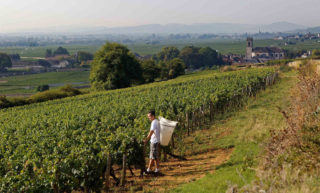Dry white wines are redefining Hungary’s best-known wine region
Tokaj-Hegyalja, the wine region in northeastern Hungary, has a long history of making renowned lusciously sweet wines. But 45 years under communist rules almost wiped out that tradition. As vintners endeavour to broaden Tokaj ’s identity, dry white terroir wines of increasingly high quality are now seeing the light of day. I spoke to four winemakers to get a better understanding of the region.
Standing at the top of the venerable Szent Tamás vineyard (main picture) one crisp October morning with Ákos Bihari, the chief winemaker of Mád Winery, one gets a good overview of the Tokaj region. Looking south, Bihari points towards the Tokaj hill, the last outpost of the old volcanic Zemplén Mountains. On the southside of the hill, out of sight, the town of Tokaj lies at the confluence of the Bodrog and Tisza rivers that provide a good share of the region’s autumn fog. Beyond the town that gives the region its name, the vast puszta stretches out. Right below us, off to the west, the town of Mád, the largest village appellation in the area, is nestled in the foothills. Along the flanks of the mountains toward the northwest and the northeast, the demarcated Tokaj-Hegyalja region stretches out like a V-shape. In the valleys around Mád fluffy puffs of fog are slowly being burnt off by the sun. “If we have a bit of rain in the fall, fog also develops away from the rivers,” Bihari says.
Fog. It is the quintessential helper for Tokaj’s long lasting reputation as a producer of lusciously sweet wines. In an ideal situation, the humidity of morning fog encourages the development of botrytis cinerea, a fungus, while afternoon sun prevents it from turning into grey rot. The fungus perforates the skin of the berries causing the water to evaporate slowly and the berries to shrivel, gradually changing the colour to amber, brownish-pink and finally dark-brown. The so-called Aszú berries, harvested individually in several passes, are so concentrated and low in juice that they need to be mashed into a paste, which is then macerated in must, fermenting must or finished wine. Adding fermenting must to the paste, leads to the highest extraction of flavours, while finished, unbotrytised base wine is said to highlight the character of the Aszú berries. Subsequent fermentation can stop naturally, or it can be interrupted to create wines with a desired level of residual sugar. After a minimum of 18 months of maturation in wooden casks, sometimes in the traditional small, 136-liter gönci, the wines are ready for release. The nearby Zemplén Mountains are the source of wood for many of the barrels used.
Puttonyos
Since 2013 the level of sweetness is expressed in the amount of residual sugar in the finished wine. Until then, Hungary used the historical puttonyos scale. A puttony is the traditional bucket grape pickers used to collect the Aszú berries. The number of buckets going into a traditional gönc of must or wine was used as an indication of sweetness with six being the maximum. Now 120 milligrammes per liter of residual sugar, or five puttonyos, is the minimum to qualify as Aszú wine. Anything up from 150 milligrammes per liter can be labelled as six puttonyos; anything below has to be sold as Late Harvest or Szamorodni.
Different stages of botrytis
Varieties
With seventy per cent of the planted area, furmint is king in Tokaj. Hárslevelű plays second fiddle. On an earlier trip in spring, Bihari took me into the vineyards to explain the difference between the two related varieties. “As you can see,” Bihari says, breaking off a couple of leaves, “hárslevelű has rounder leaves; they are more shallow-lobed than the furmint leaves, which make them look somewhat like lime leaves.” Not surprisingly, hárslevelű means lime leave in Hungarian. “And its bunches,” he continues, “are usually longer and looser. As for the berries, furmint is thin-skinned, making it more susceptible to botrytis.” With high acidity levels, even when fully ripe, furmint is the perfect base for sweet, but fresh and seldomly heavy dessert wines.
Diluted quality
Due to the very low yields of the Aszú berries, sweet Tokaji wines were traditionally expensive nectar, sought after by kings and queens. The courts of France and Russia counted among its clientele. This exclusivity however, didn’t comply with communist ideals. Not only was private land ownership forbidden, the new state cooperatives were dictated to produce affordable Tokaji for the people. (Tokaj is the name of the town, Tokaji is the name of the wine.) This inherently diluted the quality of the wines and almost eradicated the expertise to make top-notch sweet wines. But after the fall of the Iron Curtain in 1989, the traditional production methods have slowly been reclaimed. Foreign investments by companies such as AXA and Vega Sicilia also helped the region to modernize.
But there are new challenges for Tokaj-Hegyalja. Worldwide demand for sweet wines has drastically declined. Istvan Szepsy sr. was the first to recognise this development and decided to plan ahead. Since almost twenty years, he has produced dry white wines from Tokaj’s signature white grapes furmint and hárslevelű. Many vintners have followed suit. With 54 hectares under vine and an average annual production of seventy thousand bottles, yields are distinctively low. Apart from one multi-parcel cuvée, most of their dry wines are single vineyard wines. Istvan jr., one of the next generation Szepsy’s, tells me how they work in the cellar. Hand harvested grapes are destemmed and, depending on volume, pressed in a basket press (low volume) or a pneumatic press. The must is cleared by sedimentation and then inoculated with a pied de cuve, a yeast culture Szepsy developed and maintains himself. After fermentation the wine ages in a mix of old and new 300-liter barrels. The vinification of all single vineyard wines is the same. The difference in flavour and aroma can hence be largely attributed to the terroir. Szepsy also produces an Aszú wine and a so-called Szamorodni. Szamorodni, meaning “as it comes”, is a sweet wine from bunches of grapes that contain partly healthy and partly botrytised berries. “The best Szamorodni comes from bunches that are evenly botrytised, but not botrytised and shrivelled enough to be used for Aszú wines,” Szepsy jr. explains. “The origin of Aszú wines,” he continues, “lies in the Szamorodni wines. When vintners started to notice that great wines could be made from partly botrytised bunches, the process of making wines with ever larger quantities of affected berries started to evolve. Now Szamorodni is seen as Aszú’s inexpensive sibling, but the best ones can be as good.” And how to pair it with food? Szepsy doesn’t have to think long: Breaded and deep-fried pig’s brain with chilli and garlic, a local delicacy typically eaten at slaughter time in autumn.
Health claims
Szepsy jr. is not a big fan of Eszencia, an extremely intense sweet wine made of the pure free run juice of Aszú berries. The sugar content is so high fermentation is extremely slow and seldomly reaches alcohol levels of more than five per cent. “As a winemaker there is very little you can do, which makes it uninteresting for me,” Szepsy says. Ákos Bihari, from the Mád winery is more practical. “Eszencia is said to contain small amounts of antibiotics, so I give a spoonful each day to my children.”
Szepsy jr. claims Tokaji wines have other health benefits too. “The university of Debrecen,” he says, “discovered that Tokaji wines contain minerals the human body can metabolise into vitamin C.” A potentially powerful unique selling point.
Terroir
The other trailblazer for dry white wines is Zoltán Demeter. After a lengthy career that brought him to France and the USA, he came back to Hungary to take responsibility for winemaking at Grof Degenfeld. But being a self-proclaimed perfectionist, he prefers to do things exactly the way he wants them, so he decided to go solo. In his meticulously manicured winery in the heart of Tokaj, he shows me the vineyard maps of Burgundy and Tokaj. Tokaj already had demarcated first, second and third growth vineyards in the mid-seventeenth century. No wonder that most wineries are keen to label their wine with the vineyard name. In the intimate tasting room, we try a dry Furmint from 35-year-old vines from the Kakas vineyard and a dry Hárslevelű from 60-year-old vines from the Szerelmi vineyard. The overarching quality of Demeter’s premium wines is that they are very precise, just as their creator. Having a good commercial instinct, he now also produces an orange wine. “As an alternative for a red wine”, he says. Indeed, Tokaj is an almost exclusively white wine region.
Judit Bodó and her husband Jószef Bott, the last winemakers I speak to, are just as eager to express the terroir of their vineyards. I meet them at a picturesque painstakinlgy renovated former press house in the middle of the vineyards, where they host tastings. Belonging to the Hungarian minority in Slovakia, they settled, somewhat off-the-cuff, in Tokaj. Their first vineyard was a wedding gift. Now they have five across the region. The vineyards each have their own specific character and expression, something Judit and Jószef continuously explore. The Teleki vineyard, on the slopes of the Tokaj hill, for example, has high löss content. Hence, the wine is slightly creamier, and, Judit says, “over time they show more development than the wines from the foothills of the Zemplén Mountains.” Judit and Jószef’s wines are sought-after material. Every year within three days after release, all bottles are sold.
Sparsely populated
Besides falling demand for sweet wine, the famed wine region faces another challenge. Their main goal, as Judit explains, is to lay a solid foundation for the next generation. She and Jószef have three young sons, and they hope one of them will eventually take over the business. However, Tokaj-Hegyalja is a sparsely populated region and young people tend to move away. To counter that, Judit organises an annual winemaking event for young people teaching them the traditions of winemaking and hopefully inspiring them to stay. “All the same,” she stresses, “my children should make their own choices in life.”
Despite the challenges, thirty years after the Iron Curtain was lifted, the Tokaj wine region is successfully underway reinventing itself. With furmint and hárslevelű meeting the growing interest in indigenous grape varieties and with the increasing quality of the dry white terroir-driven wines, the future seems bright. And with some promising health claims of Tokaji, a whole new market may open up.
Visited wineries:
Bott Pince
Mád winery
Szepsy Pince
Demeter Zóltan
A version of this article (in Norwegian) was published in the December 2019 issue (print) of Apéritif magazine.
A version of this article (in Dutch) was published on Perswijns website in April 2020.








Comments